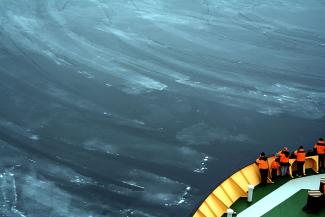
-
Date
by Daniel Watkins/Oregon State University
Once every hour, a pair of volunteer ice observers climbs up to the 8th floor of the ship and goes out on the observation deck to watch the ice. For 10 minutes, they watch sea ice pass by the ship. They note how much ice there is, and if there is any water visible, whether it is only in cracks, in patches, or in wide channels called leads. They watch the ice turning and moving in the water next to the ship as the ship pushes through the ice. A pole with 10 centimeter stripes juts out of the side of the ship and provides a reference point for the observers so they can estimate the thickness of the ice. The observers discuss what they see with each other: Is that patch of ice the elastic, new ice called "nilas" or is it brittle "gray ice"? Did that thicker piece form last winter and survive the summer, or is it older than that? They look for clues, like whether the surface of the ice has large, frozen-over melt ponds left over from the winter before, and whether the surface is crossed with long, well-developed ridges, like miniature mountain ranges marking areas where ice broke and piled up as the wind forced two ice floes together.
Every year, more and more volunteers on ships crossing Arctic waters report ice observations through the Ice Watch program. Organized in 2012 by the International Arctic Research Center, based at the University of Alaska, Fairbanks, the Ice Watch program coordinates volunteer ice observers and provides software that translates plain-language descriptions of sea ice conditions into the technical codes used by government agencies. Ice analysts preparing charts and forecasts for navigation use this information to complement their standard data sources, which include satellite imagery and sophisticated computer simulations. Ice Watch data is freely available at http://icewatch.gina.alaska.edu. At that website, you can see data from individual ships plotted on a map of satellite-derived sea ice concentration, and you can browse visualizations of new and historic data. You can learn more about Ice Watch at https://sites.google.com/a/alaska.edu/ice-watch/.
Over the MOSAiC year, supply ships will be visiting the Polarstern at the central MOSAiC observatory approximately every two months. Aboard each of these ships will be an experienced Ice Watcher and eager new volunteer ice observers. By the end of MOSAiC there will be a collection of ice observations from every season, allowing sea ice researchers such as Jennifer Hutchings at Oregon State, who is coordinating the MOSAiC Ice Watches, to carry out research on the yearly cycle of ice growth and melt, as seen through the eyes of over one hundred volunteers.